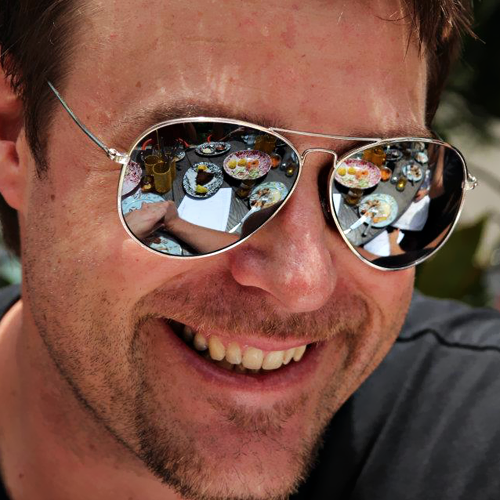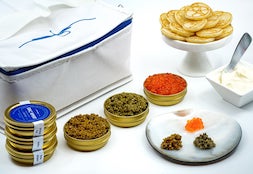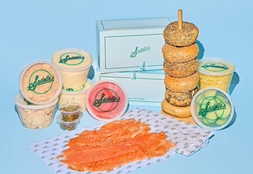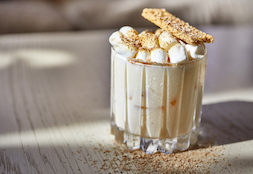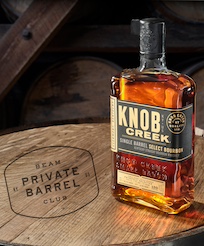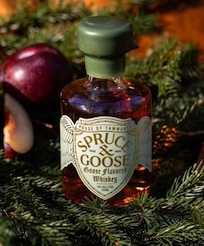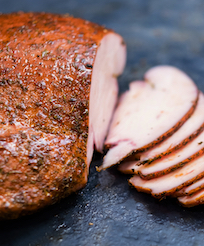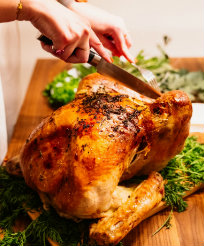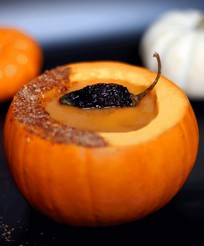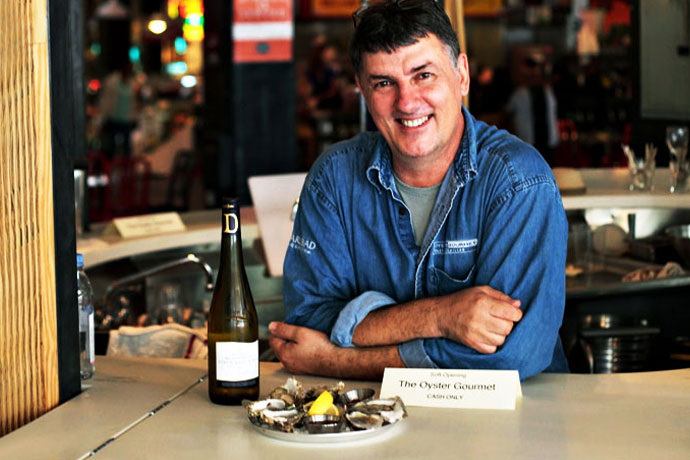
Christophe Happillon owns and operates the Oyster Gourmet, a mini mecca for oyster lovers in Downtown LA’s
Grand Central Market. The city’s only master écallier (a French term for shellfish master), this French
native knows more about bivalves than, well, probably anyone. And he sat down with UrbanDaddy for 12 probing
questions into the shellfish he’s dedicated his life to.
1) “He was a bold man that first ate an oyster.” Jonathan Swift said that. What do we actually know about the first man to eat an oyster?
We find that people have been eating oysters since Paleolithic times—we’re talking roughly 45,000 years ago. And we’ve got proof that people at this time were eating oysters all over Europe and Asia, as well as in Africa. So it’s a very old food. In a way, it’s a meat that doesn’t run, so when you understand the tides, you may have said, “Okay, at some point during the day, all during the year, we can get an excess of food here.”
2) What are the world’s most coveted oysters?
I think it depends on where you come from. In Europe, it’s going to be Bélon. It’s not very rare, but it’s not an easy species to grow. Then there is also small production to consider, like in the Olympia oyster. It is coveted due to small production. It’s like diamonds. What makes the value is that it’s rare.
3) You’ve dedicated your life to oysters. What do you think of their reputation as aphrodisiacs?
Well, we know the placebo effect is very important. So when you believe in something, you’re putting your mind into it, and there’s a good chance that you’re going to say, “Oh, I feel that I can perform better.”
The other factor comes from early medicine and the approach of how to choose what kind of plant versus another one will heal a certain type of ailment. And one way to narrow it down was looking to the shape of a root or plant. So with oysters, maybe it’s the same thing. When you open them, because they are a bivalve and there’s a delicate mantle to filter the water, it looks like a vulva. Half-open, you’ve got soft flesh inside, so it’s a symbol of femininity.
4) How should great oysters be eaten?
They can be eaten in many ways. For me, a really great oyster should be at the temperature of the water where you pick them up. It’s not necessarily about being cold; it’s really more about the texture of the flesh and the quality of the water. So I like mine au naturel, with maybe a drop of lemon or vinegar, but very simple and traditional. Using lemon or vinegar balances the salt content by adding acidity, so it allows you to avoid this salty effect and better appreciate the flavor of the flesh. It’s also a way to clean your palate.
5) What drinks best complement oysters?
I recommend any kind of acidic wine, aged in steel, not oak, because the wood is going to influence the wine. Any bubbles are good, too, like prosecco or champagne, as they are going to help clean the palate.
Beer is also a great match. Stout in particular is outstanding. In fact, in some parts of the world, like Ireland, oysters were always matched with stout. And they made some stouts with oyster shells for flavor.
A dry sake is a good match, too. You could even argue that some waters are a great match for oysters. It’d be interesting to do a pairing with oysters and water. I’m talking about mineral water and spring water, because each spring has its own spectrum in terms of taste due to the pH, mineral content and bubbles. It’d be interesting. And also kind of expensive, since water is so expensive these days.
6) What is the greatest oyster you’ve eaten?
From the West Coast, I had the opportunity to get my hands on the Totten Inlet, a Puget Sound oyster, and they were amazing. They’re rich, meaty and complex—there’s a different layer, some kind of softness—almost like a foie gras. First there’s that richness, then it’s sort of creamy, but more like crème fraîche than milky. There’s a density and a complexity there because they have big muscles. And the muscles are basically formed from glycogen, which is a long chain of sugar, which is what gives sweetness to the oyster.
7) How do you describe oysters to someone who’s never tasted one?
It’s very hard to explain what it is. To me, it’s a sense of the sea. The sea in a solid state. You can’t eat the sea, but with an oyster, the ocean is embedded in your hand, bearing all the complexities of the sea. And there’s a subtleness to oysters. A good one always has a lingering finish, like a great wine.
8) Where should people travel when seeking great oysters?
You can go to the East Coast, from Massachusetts to New Brunswick and PEI, because there’s a good concentration of oysters that taste different from one another. There’s a very clean line between the oysters from those areas. You should also go to New Orleans, which is a mecca for oysters. And there they’re going to cook them, they’re eating them raw, there are so many different preparations. It’s one of the richest places in the world to grow oysters.
And I would also recommend Washington State. There are so many oysters between Hood Canal and Puget Sound and the San Juan Islands, and then up to Canada where you have access to plenty of terrific oysters. And then you can always go to Europe to Brittany and Gascony. You just have to be open and curious.
And the best method is to visit the oyster farms. A lot of the farmers are willing to welcome you and talk with you. They love that and it’s the best way to understand the oyster and the passion and long process behind growing the oyster. It takes over 36 months to grow them sometimes, which is a lot of attention to put on this little critter.
9) What can you tell about oysters just from looking at the shell?
You can tell the species, first of all. There’s a difference in the shape and the smoothness. Eastern oysters are smooth and have a bigger ratio of calcium to flesh than the Western oyster. You can also tell by the weight. If it’s full or not as full. If it’s a little bit heavy, you sort of know, “Okay, this is a good one.”
10) Grilled and fried oysters. Blasphemy or no?
No, these are good. It’s interesting. I think you lose a little bit of the delicacy of the product, which is why you put things like parmesan cheese, butter or garlic on them. Everything is good with butter. Or fried. You can’t argue that oysters fried aren’t going to be good, right?
I’m more of a purist myself. But I’m not a chef either, so I can’t really argue what is good and what is not. I mean, I’ve got good taste, as I’m French. But if you cover something with too many complexities, even as you add something, you’re still taking something away.
My philosophy is: I’d better source a great oyster from the start. It’s not about, like, finding the best mignonette and putting tarragon in it. That’s good, but that is not the point for me.
11) What’s the greatest misconception about oysters?
Sliminess. Most of the time, people think it is slimy. I used to do a lot of pop-up oyster bars. So when people would say, “No, it’s slimy”... Well, it’s not. But there’s sort of a sales tactic where you can say to people, “Do you like yogurt?” Well, yogurt is slimy. “Do you like mango?” Yes. Well, mango has a sort of sliminess. And then after, I say, “Do you like sex?” So, after all these questions, with people answering yes, yes, yes, then they can start with a clean slate, having taken away their misconceptions. Sometimes you have to push a little. So sliminess is the first thing, and a good oyster is never slimy.
12) What about the future of oysters? Is there anything that’s changing the industry for good or bad?
That’s a good question. It’s a trendy food right now. So a lot of people dive into it for that reason. Which in a way is going to help the industry develop.
And there is the problem of pollution that’s creeping up. We’re not there yet. There are always good parts in the ocean. But if we expect the water levels to increase, all the pollution that is now above the water is going to be in the water. Right now, there are plenty of good oysters, and for years to come there shouldn’t be any problem. But long term, when you look in terms of generations, there are concerns. We’ll see.
1) “He was a bold man that first ate an oyster.” Jonathan Swift said that. What do we actually know about the first man to eat an oyster?
We find that people have been eating oysters since Paleolithic times—we’re talking roughly 45,000 years ago. And we’ve got proof that people at this time were eating oysters all over Europe and Asia, as well as in Africa. So it’s a very old food. In a way, it’s a meat that doesn’t run, so when you understand the tides, you may have said, “Okay, at some point during the day, all during the year, we can get an excess of food here.”
2) What are the world’s most coveted oysters?
I think it depends on where you come from. In Europe, it’s going to be Bélon. It’s not very rare, but it’s not an easy species to grow. Then there is also small production to consider, like in the Olympia oyster. It is coveted due to small production. It’s like diamonds. What makes the value is that it’s rare.
3) You’ve dedicated your life to oysters. What do you think of their reputation as aphrodisiacs?
Well, we know the placebo effect is very important. So when you believe in something, you’re putting your mind into it, and there’s a good chance that you’re going to say, “Oh, I feel that I can perform better.”
The other factor comes from early medicine and the approach of how to choose what kind of plant versus another one will heal a certain type of ailment. And one way to narrow it down was looking to the shape of a root or plant. So with oysters, maybe it’s the same thing. When you open them, because they are a bivalve and there’s a delicate mantle to filter the water, it looks like a vulva. Half-open, you’ve got soft flesh inside, so it’s a symbol of femininity.
4) How should great oysters be eaten?
They can be eaten in many ways. For me, a really great oyster should be at the temperature of the water where you pick them up. It’s not necessarily about being cold; it’s really more about the texture of the flesh and the quality of the water. So I like mine au naturel, with maybe a drop of lemon or vinegar, but very simple and traditional. Using lemon or vinegar balances the salt content by adding acidity, so it allows you to avoid this salty effect and better appreciate the flavor of the flesh. It’s also a way to clean your palate.
5) What drinks best complement oysters?
I recommend any kind of acidic wine, aged in steel, not oak, because the wood is going to influence the wine. Any bubbles are good, too, like prosecco or champagne, as they are going to help clean the palate.
Beer is also a great match. Stout in particular is outstanding. In fact, in some parts of the world, like Ireland, oysters were always matched with stout. And they made some stouts with oyster shells for flavor.
A dry sake is a good match, too. You could even argue that some waters are a great match for oysters. It’d be interesting to do a pairing with oysters and water. I’m talking about mineral water and spring water, because each spring has its own spectrum in terms of taste due to the pH, mineral content and bubbles. It’d be interesting. And also kind of expensive, since water is so expensive these days.
6) What is the greatest oyster you’ve eaten?
From the West Coast, I had the opportunity to get my hands on the Totten Inlet, a Puget Sound oyster, and they were amazing. They’re rich, meaty and complex—there’s a different layer, some kind of softness—almost like a foie gras. First there’s that richness, then it’s sort of creamy, but more like crème fraîche than milky. There’s a density and a complexity there because they have big muscles. And the muscles are basically formed from glycogen, which is a long chain of sugar, which is what gives sweetness to the oyster.
7) How do you describe oysters to someone who’s never tasted one?
It’s very hard to explain what it is. To me, it’s a sense of the sea. The sea in a solid state. You can’t eat the sea, but with an oyster, the ocean is embedded in your hand, bearing all the complexities of the sea. And there’s a subtleness to oysters. A good one always has a lingering finish, like a great wine.
8) Where should people travel when seeking great oysters?
You can go to the East Coast, from Massachusetts to New Brunswick and PEI, because there’s a good concentration of oysters that taste different from one another. There’s a very clean line between the oysters from those areas. You should also go to New Orleans, which is a mecca for oysters. And there they’re going to cook them, they’re eating them raw, there are so many different preparations. It’s one of the richest places in the world to grow oysters.
And I would also recommend Washington State. There are so many oysters between Hood Canal and Puget Sound and the San Juan Islands, and then up to Canada where you have access to plenty of terrific oysters. And then you can always go to Europe to Brittany and Gascony. You just have to be open and curious.
And the best method is to visit the oyster farms. A lot of the farmers are willing to welcome you and talk with you. They love that and it’s the best way to understand the oyster and the passion and long process behind growing the oyster. It takes over 36 months to grow them sometimes, which is a lot of attention to put on this little critter.
9) What can you tell about oysters just from looking at the shell?
You can tell the species, first of all. There’s a difference in the shape and the smoothness. Eastern oysters are smooth and have a bigger ratio of calcium to flesh than the Western oyster. You can also tell by the weight. If it’s full or not as full. If it’s a little bit heavy, you sort of know, “Okay, this is a good one.”
10) Grilled and fried oysters. Blasphemy or no?
No, these are good. It’s interesting. I think you lose a little bit of the delicacy of the product, which is why you put things like parmesan cheese, butter or garlic on them. Everything is good with butter. Or fried. You can’t argue that oysters fried aren’t going to be good, right?
I’m more of a purist myself. But I’m not a chef either, so I can’t really argue what is good and what is not. I mean, I’ve got good taste, as I’m French. But if you cover something with too many complexities, even as you add something, you’re still taking something away.
My philosophy is: I’d better source a great oyster from the start. It’s not about, like, finding the best mignonette and putting tarragon in it. That’s good, but that is not the point for me.
11) What’s the greatest misconception about oysters?
Sliminess. Most of the time, people think it is slimy. I used to do a lot of pop-up oyster bars. So when people would say, “No, it’s slimy”... Well, it’s not. But there’s sort of a sales tactic where you can say to people, “Do you like yogurt?” Well, yogurt is slimy. “Do you like mango?” Yes. Well, mango has a sort of sliminess. And then after, I say, “Do you like sex?” So, after all these questions, with people answering yes, yes, yes, then they can start with a clean slate, having taken away their misconceptions. Sometimes you have to push a little. So sliminess is the first thing, and a good oyster is never slimy.
12) What about the future of oysters? Is there anything that’s changing the industry for good or bad?
That’s a good question. It’s a trendy food right now. So a lot of people dive into it for that reason. Which in a way is going to help the industry develop.
And there is the problem of pollution that’s creeping up. We’re not there yet. There are always good parts in the ocean. But if we expect the water levels to increase, all the pollution that is now above the water is going to be in the water. Right now, there are plenty of good oysters, and for years to come there shouldn’t be any problem. But long term, when you look in terms of generations, there are concerns. We’ll see.

